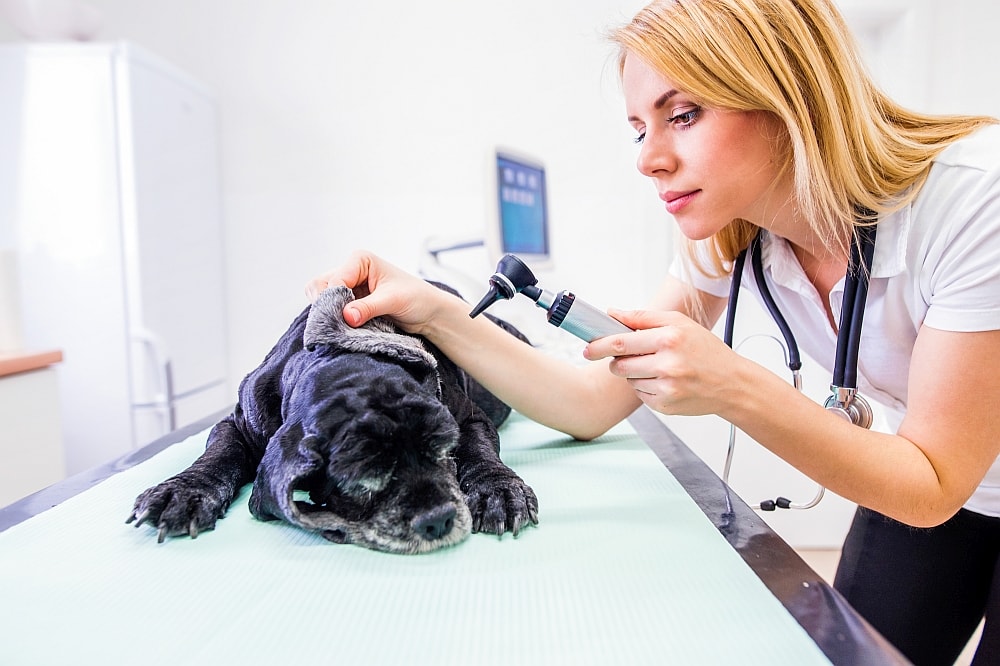Most healthy dogs have pretty robust immune systems, which are capable of eliminating bacteria that would quickly sicken you or me.
And it’s a good thing they do – given their penchant for rolling in the dirt, sniffing poop at very close range, and licking anything vaguely interesting, dogs encounter bacteria constantly.
But that doesn’t mean their immune systems are infallible. Every once in a while, they encounter a bacterial strain that is capable of evading their defenses, and setting up shop. But fortunately, modern dogs can be given antibiotics to help eliminate these pathogens and return to good health.
There are a number of different antibiotics veterinarians prescribe for sick dogs, but one of the most common is called Cephalexin (also spelled Cefalexin).
Cephalexin and Dogs: Key Takeaways
- Cephalexin is a common antibiotic used to treat a variety of bacterial infections.
- Cephalexin is a relatively old medication, which was first developed in 1967.
- While it isn’t right for all dogs, cephalexin is well-tolerated by most canines.
What Is Cephalexin and What Does It Treat In Dogs?
Known by brand names such as Keflex, Cefadroxil and Biocef, cephalexin is a type of medication known as a first-generation cephalosporin. Somewhat similar to penicillin, cephalexin is better suited for treating some bacterial strains than others.
Cephalexin kills both gram-positive and some gram-negative bacteria (you can read more about the differences between these two types of bacteria here) by disrupting the way bacteria create their cell walls. Cephalexin withstands passage through the intestinal tract well, which helps ensure that it enters the bloodstream and is distributed to the target area.
Originally created in 1967, this antibiotic is used to treat people and other animals in addition to dogs. In fact, it even appears on the World Health Organization’s List of Essential Medicines, because it is such a helpful drug for treating a variety of bacterial infections.
Cephalexin is used to treat infections occurring in several different parts of the body, including the bones, skin, ears, urinary tract and lungs. It has a broad spectrum of efficacy, and is helpful for treating infections caused by the following bacteria:
- Several different staphylococci, including Staphylococcus aureus and Streptococcus pneumonia
- A variety of streptococci, including Streptococcus pyogenes
- Haemophilus influenza
- Escherichia coli
- Klebsiella pneumonia
- Proteus mirabilis
But cephalexin is not effective against all bacteria. For example, Pseudomonas, Enterococci, and Enterobacter are not affected by the drug.
In many cases, veterinarians may prescribe cephalexin to begin treating an infection while waiting for the results of cultures taken during an office visit.
Once the bacteria in question has been positively identified and the lab has determined which antibiotics will treat it, the vet may change the prescription to a more effective medication.
Cephalexin Is Available For Dogs By Prescription Only
Cephalexin is only available by prescription, so you’ll need to visit your veterinarian if you suspect your dog is suffering from some type of bacterial infection.
Although this is frustrating to many owners, there are three important reasons cephalexin is treated as such:
- Some dogs are allergic to cephalexin, while others may suffer from conditions that cephalexin can exacerbate.
- Some dogs may be taking medications that will interact with the antibiotic in potentially dangerous ways.
- Improper use, administration and disposal of antibiotics can lead to bacterial resistance, which is a serious concern in the modern world.
Accordingly, you’ll always want to follow your vet’s instructions regarding cephalexin to give your dog the best chance of recovering from the infection that is troubling her.

Cephalexin Dosage For Dogs: What’s Appropriate?
Your veterinarian will determine the proper cephalexin dosage for your pet, so you should always follow his or her instructions to the letter.
Different dosages are used to treat different bacterial strains and infections in different parts of the body, however, cephalexin is usually prescribed at a dosage of 15 mg/kg, although some vets prefer to prescribe dosages of 30 miligrams/kg in severe cases.
The medication is generally given via oral tablets, and administered every 8 to 12 hours (one to three times per day).
Your veterinarian may alter this dosage as necessary for your pet’s specific circumstances. For example, dogs suffering from kidney disease or kidney failure may require reduced doses. The duration of the treatment will also vary based on a number of factors too.
It is important to note that some bacterial infections will require multiple treatment regimens to eradicate the offending pathogens.
This will often necessitate the regular collection of cultures to monitor the bacteria, and it may be necessary for veterinarians to change the dosage or switch to another antibiotic altogether to avoid problems with antibiotic resistance.
Cephalexin is prepared in several different forms, and your vet will prescribe the one best suited for your dog’s needs. Most commonly, the medication comes in capsules which should be swallowed. However, there are chewable formulations, which are a better option for some dogs. An oral suspension (liquid) is also available as is an injectable form.
Side Effects of Cephalexin in Dogs
Most dogs tolerate cephalexin well, and side effects are generally rare and mild. However, it is always wise to watch out for changes in your dog’s health, behavior and demeanor, which should be reported to your vet promptly.
Some of the side effects include:
- Drooling
- Nausea
- Vomiting
- Excessive panting
- Hyperactivity
Additionally, as with just about every medication available, cephalexin may cause allergic reactions in a small number of dogs. This can manifest in symptoms like skin rashes, facial swelling, or difficulty in breathing.
If you note any of these signs, contact your veterinarian immediately.
Many veterinarians recommend giving cephalexin along with food to help reduce the likelihood of intestinal upset. However, some dogs appear to tolerate the medication well without food.
You may also want to ask your vet about incorporating a probiotic anytime you administer a broad-spectrum antibiotic to your dog. This may help ensure that your dog’s intestinal tract remains colonized by beneficial bacteria, which may help prevent diarrhea and other types of gastrointestinal distress.
Cephalexin and Canines: General Safety Information
As with any other prescription medication, it is important to use cephalexin responsibly and to follow your veterinarian’s instructions faithfully.
Never use antibiotics or other prescription medications for other dogs in your home, unless your vet has given you permission to do so.
Always complete the entire course of medication as instructed by your vet, even if your dog’s symptoms begin to go away. Prematurely halting your dog’s medication can allow the infection to come roaring back, making treatment more difficult.
Always dispose of unused medications properly and only when your vet instructs you to do so.
Additionally, you’ll always want to watch for signs that your dog is allergic to the medication.
Typically, allergic reactions take the form of hives or excessive itching, but in some cases allergic reactions can lead to difficulty in breathing, low blood pressure, or even cause dogs to enter a coma. Always contact your vet immediately at the first sign of an allergic reaction.
Alternative Antibiotics for Dogs
Cephalexin is not appropriate in some situations and for some dogs.
Fortunately, veterinarians have a number of other antibiotics that can be used in its place. Penicillin is one of the most common alternatives, although amoxicillin may be used in other cases.
Some dogs may not even require antibiotics at all. Warm compresses can be used in some cases to enhance blood-flow to the afflicted region. This blood helps carry oxygen and white blood cells to the area, which can help to kill the bacteria and clear the infection.
***
Has your vet every prescribed cephalexin for your dog? How did the treatment go? Did it clear up your dog’s infection? We’d love to hear your experiences in the comments.








Leave a Comment